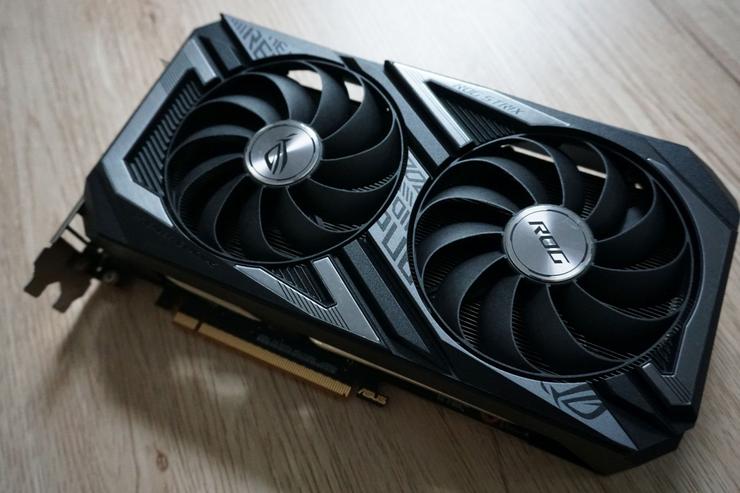 Credit: Brad Chacos/IDG
Credit: Brad Chacos/IDG
AMD promised the Radeon RX 6600 XT would deliver “epic” 1080p gaming, and the company’s latest graphics card delivers that in spades. This RDNA 2-powered GPU doesn’t just blow past the Radeon RX 5600 XT it’s replacing, it also skirts by the Radeon RX 5700 XT—a graphics card not one but two tiers higher than the 5600 XT was. Impressive stuff. The Radeon RX 6600 XT will absolutely scream when paired with a high refresh-rate monitor.
On the other hand, that lead diminishes more than you might expect when you bump up the resolution to 1440p. That’s due to some key tweaks introduced in the Radeon RX 6600 XT’s memory subsystem and its implementation of AMD’s radical new Infinity Cache. You also can’t ignore the sticker price: The Radeon RX 6600 XT carries a suggested price tag of US$379, a full US$100 more than the 5600 XT was and just US$20 shy of the cost of the Radeon RX 5700 XT (and Nvidia’s fantastic GeForce RTX 3060 Ti). Yes, we’re in the midst of a crippling GPU shortage. This graphics card will no doubt both cost more and sell out instantly on the streets.
Add it all up and the Radeon RX 6600 XT is a good graphics card with some complicated caveats. Let’s dig in, with the help of the Asus ROG Strix Radeon RX 6600 XT, a premium custom model with an incredibly luxe US$550 price tag that's probably more reflective of what you'll see in the real world.
Radeon RX 6600 XT specs, features, and price
The Radeon RX 6600 XT is built on AMD’s new RDNA 2 architecture, specifically the “Navi 23” GPU that’s considerably smaller in size than the Navi 22 and 21 GPUs found in step-up cards like the Radeon RX 6700 XT and flagship 6900 XT. That matters for several technical reasons, but practically, smaller die sizes mean AMD can squeeze more out from each silicon wafer it manufactures. More GPU dies mean more graphics cards hitting the streets—stellar news during a shortage.
Here’s a quick look at how the US$379 Radeon RX 6600 XT’s reference specifications stack up against both the US$279 Radeon RX 5600 XT and US$399 Radeon RX 5700 XT from last generation:
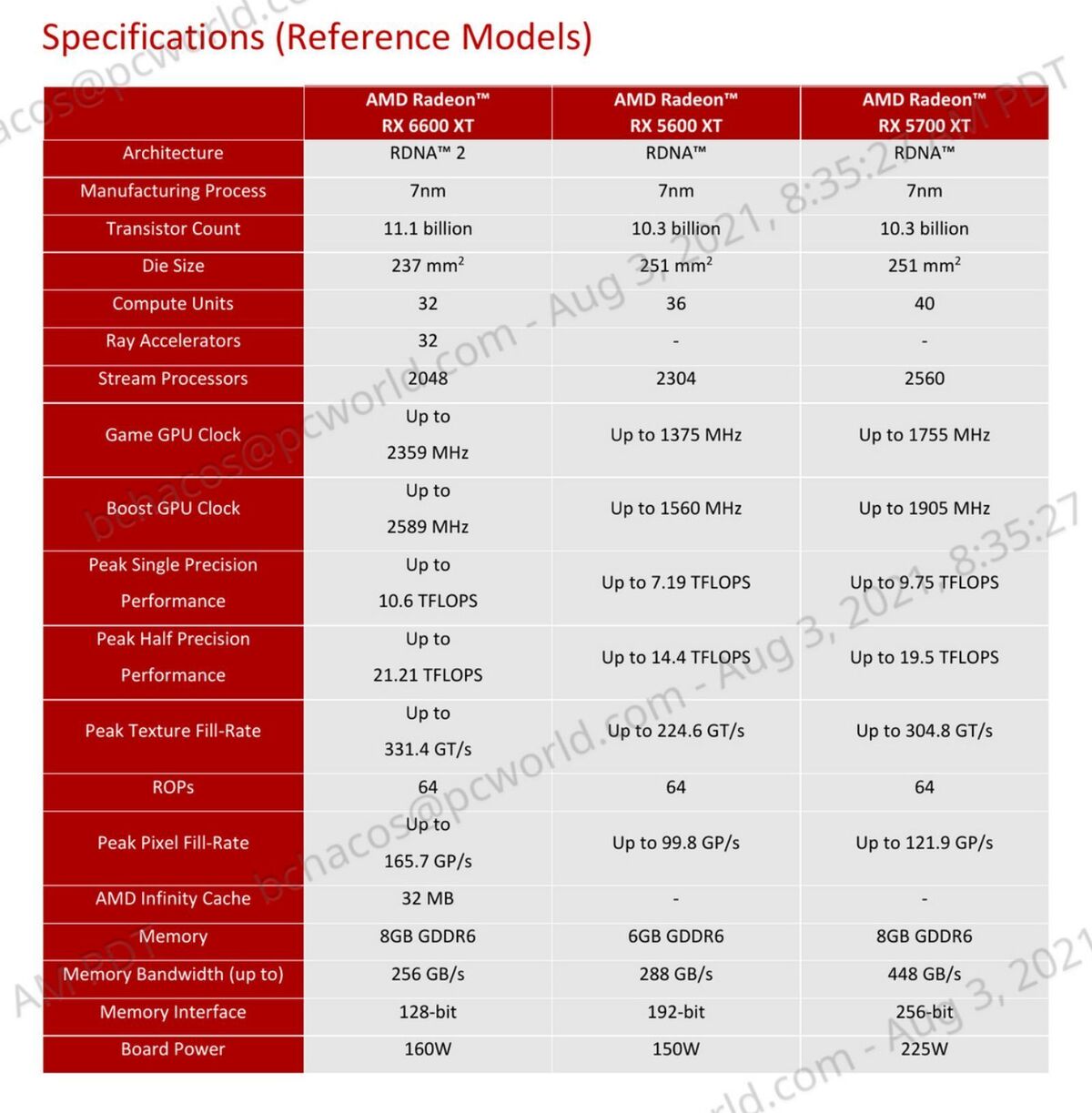 AMD
AMDRDNA 2 hits significantly higher clock speeds than its predecessors did. Just witness the “Game Clock” speeds—the average clock speed expected while gaming—for the 5600 XT and 6600 XT. AMD’s new card is very nearly 1,000MHz higher. Sweet holy moly. Despite those sky-high speeds, and the addition of 2GB more memory (bringing the total to 8GB), the Radeon RX 6600 XT draws only 10 watts more power than the card it’s replacing, a testament to RDNA 2’s advances.
Part of the reason AMD’s new cards are so power-efficient is the addition of “Infinity Cache,” a large blob of L3 memory embedded right within the GPU die. Games tap into it for a lot of memory tasks, which means the GPU doesn’t need to send requests “all” the way out to the graphics card’s GDDR6 memory. That in turn lets AMD build Radeon RX 6000-series GPUs with smaller memory buses, which helps save power. Think of the memory bus as the highway for memory data: More lanes lets traffic move faster. The Radeon RX 6600 XT features a narrow 128-bit memory bus, versus a 192-bit bus on the older 5600 XT, and a 256-bit bus on the 5700 XT.
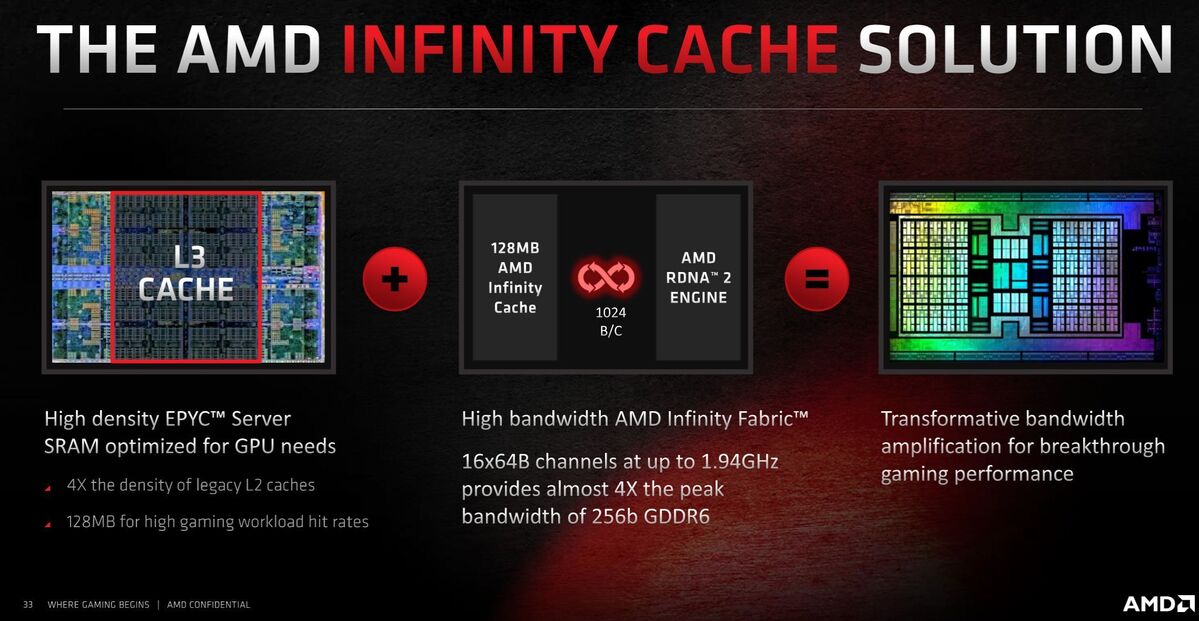 AMD
AMD
Infinity Cache is truly a game-changer, but the Radeon RX 6600 XT's 1440p performance shows its implementation matters.
It’s not all roses, though. AMD tuned the Radeon RX 6600 XT’s Infinity Cache for 1080p gaming, giving it significantly less capacity than its siblings—32MB, versus 96MB on the 1440p-focused Radeon RX 6700 XT and 128GB on AMD’s higher-end 4K options. Radeon product manager Nish Neelalojanan told me that the “hit rate” that determines the Infinity Cache’s effectiveness is “very similar” in the 6600 XT at 1080p to what the other cards achieve at their targeted resolutions.
But as you’ll see in our benchmarks, if you step the resolution up to 1440p, the Infinity Cache’s hit rate decreases significantly, meaning the 6600 XT needs instead to rely on the traditional memory system much more. When that happens, the Radeon RX 6600 XT’s lead over the older 5700 XT plummets--and sometimes disappears completely. That makes sense: The 5700 XT’s much wider bus helps boost it to 448GBps of memory bandwidth, compared to 256GBps on the Radeon RX 6600 XT. (Infinity Cache isn’t counted in that—it’s much faster.) Also, 1440p textures put greater demand on memory. But it also means that while the Radeon RX 6600 XT does well enough at 1440p gaming, it shines brightest at high refresh-rate 1080p.
Enough chip geekery. Let’s talk about the US$550 Asus ROG Strix Radeon RX 6600 XT more specifically.
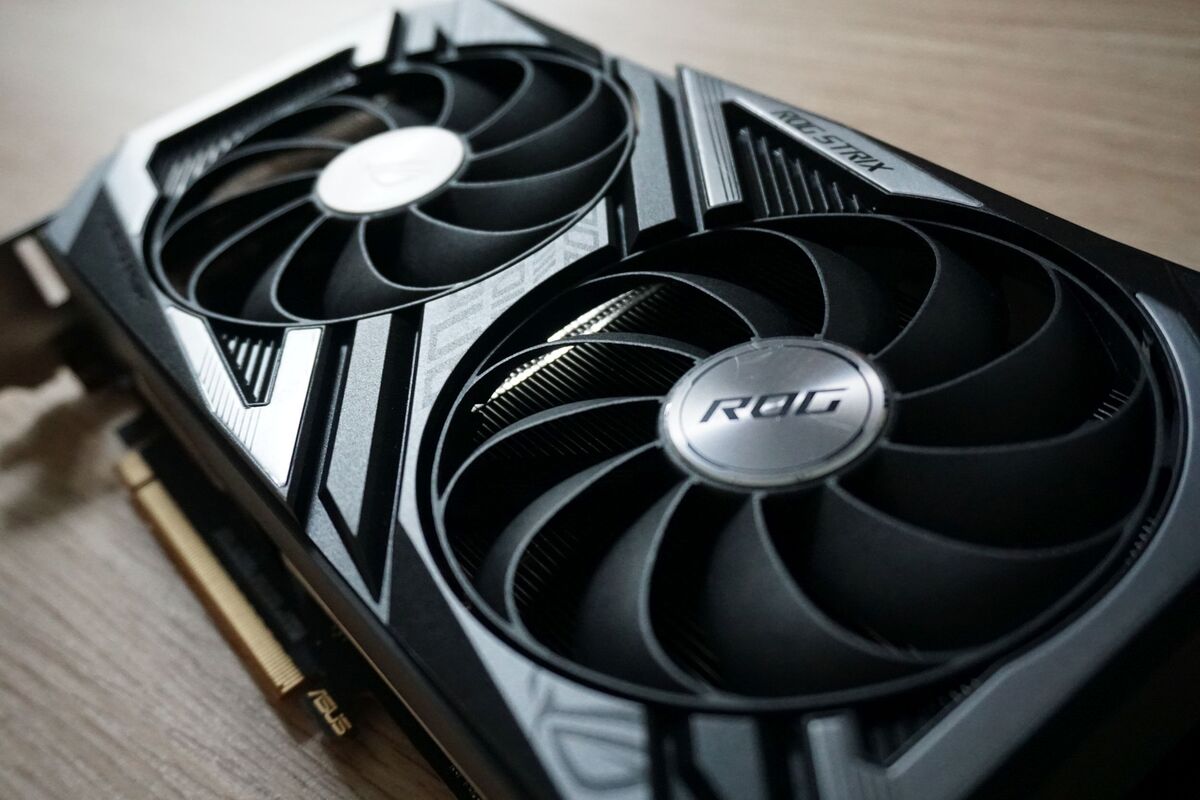 Brad Chacos/IDG
Brad Chacos/IDGThis more mainstream version of Asus’s ROG Strix flagship brand doesn’t have quite as many bells and whistles as the most premium offerings. The shroud is more plasticky and lacks RGB lighting aside from a logo on the edge. There aren’t any FanConnect II headers to integrate a case fan’s performance with the GPU’s temperature, and it’s smaller in general.
 Brad Chacos/IDG
Brad Chacos/IDG
The "ROG Strix" logo on the edge features RGB lighting.
Those sorts of sacrifices are common in more affordable graphics cards, and the ROG Strix Radeon RX 6600 XT’s cooling design still impresses. The dual fans feature many steeply swept blades encased in an outer ring. They sit over a heatsink that houses four heatpipes and a large base plate to suck heat away from the GPU and memory modules.
This card may be compact, but it can still tame this more modest Radeon GPU. As you’ll see in our benchmark section, the ROG Strix RX 6600 XT delivers absolutely exceptional temperatures and noise levels. Better yet, the card offers a 0db feature that turns the fans off for silent operation when you aren’t stressing the GPU under intense gaming loads.
 Brad Chacos/IDG
Brad Chacos/IDGAesthetically, this looks like a ROG Strix thanks to its harsh, angular shroud design, augmented by futuristically styled text angled across its face. The card features a slick full-length metal backplate that’s bare aside from a swooping ROG logo. If you’re into the aggressive, almost cyberpunk-ish “gamer” aesthetic, the ROG Strix Radeon RX 6600 XT will look outstanding in your case.
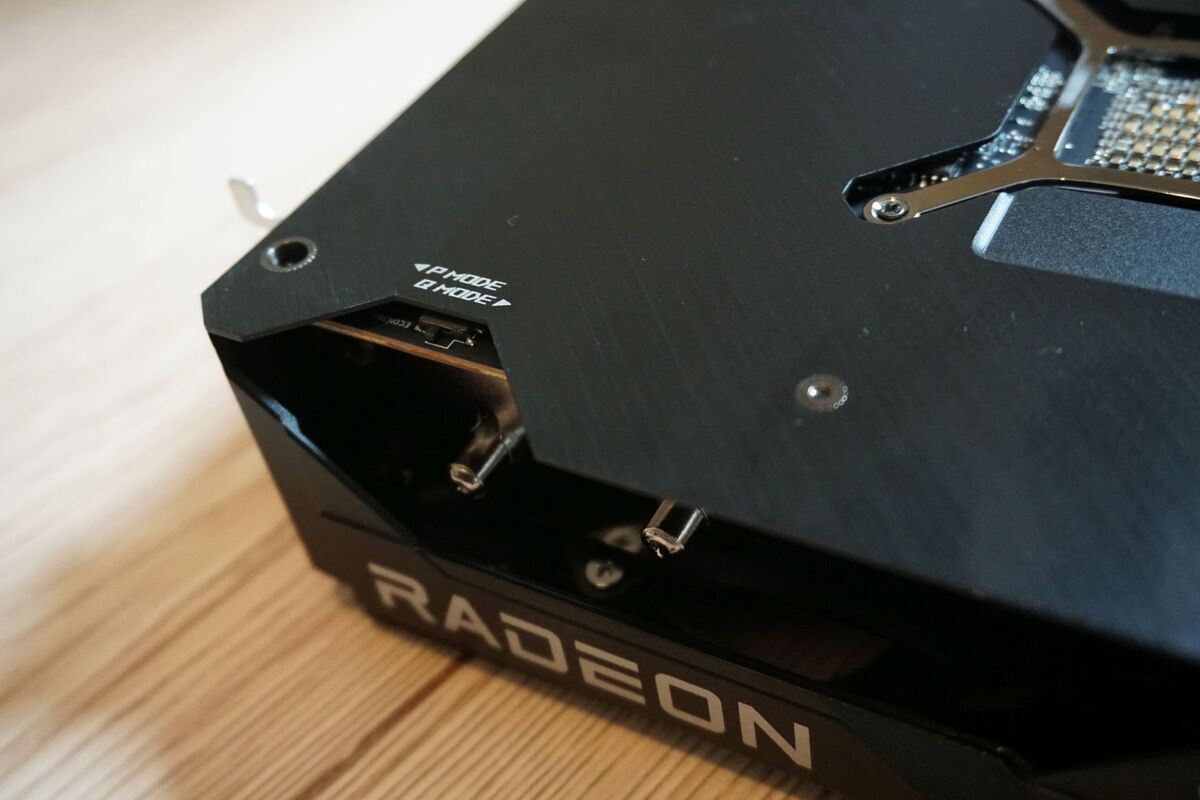 Brad Chacos/IDG
Brad Chacos/IDG
The ROG Strix's dual-BIOS switch.
On a more practical level, the card offers a dual BIOS switch—always handy for overclocking endeavors—with preset Performance and Quiet profiles, though the default Performance profile is plenty quiet on its own. Power comes via a single 8-pin connector. Asus outfitted the card with a single HDMI 2.1 connection and a trio of DisplayPorts.
 Brad Chacos/IDG
Brad Chacos/IDG
Port report
Like other RX 6000-series GPUs, the Radeon RX 6600 XT supports all of RDNA 2’s various features, including FidelityFX Super Resolution and Smart Access Memory to boost performance, real-time ray tracing capabilities, AV1 video decoding, DirectX 12 Ultimate goodies, an improved version of Radeon Boost that wraps in Variable Rate Shading, Radeon Anti-Lag across all major DX APIs, FreeSync display support, AMD Link streaming to other devices, and much more. AMD’s robust Radeon Settings app includes both manual and automatic performance tuning controls so you can tweak the card to your heart’s extent, and Asus offers its own helpful GPU Tweak III software.
Let’s get benchmarking.
Next page: Our test system, benchmarks begin

















